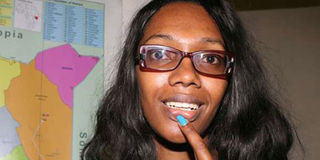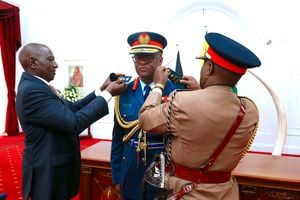Why transgender persons are not gays

Audrey Mbugua, a transgender, during an interview on October 10, 2014. She has requested Maina Kiai to stop using the challenges faced by intersex people and transgender persons to pimp up the gay rights campaign. PHOTO | WILLIAM OERI | NATION MEDIA GROUP
What you need to know:
- It is manifested by the habit of turning the experiences and struggles of minorities such as transgender and intersex persons into gay struggles.
- I call upon all human rights actors and media houses to respect transgender and intersex people and refrain from placing gay labels on them.
Old habits die hard. The gaynisation of transgender and intersex people is a common and morally accepted theme in human rights circles and media houses.
Gaynisation refers to the immoral act of terming people who are not gays as gays.
It is manifested by the habit of turning the experiences and struggles of minorities such as transgender and intersex persons into gay struggles.
A case in point is Maina Kiai’s article titled ‘No one chooses to become gay, it depends on how one was created’ (Saturday Nation, August 27, 2016).
Mr Kiai serves as the United Nations Special Rapporteur on the rights to freedom of peaceful assembly and of association.
The article starts off by castigating the president of the International Association of Athletics Federations (IAAF) for his wish to challenge a ruling that suspended the monitoring of female athletes with higher than usual levels of testosterone — testosterone is a sex hormone found both in male and females, but its levels are significantly higher among male persons.
Mr Kiai then ropes in athlete Caster Semenya from South Africa, whose colleagues at the Rio Olympics raised debate on whether Caster’s (and two other athletes) male sex hormone level gave her undue advantage over them.
Anecdotally, Semenya has been said to be an intersex individual. Intersex is defined as a status in which an individual is born with physical sex characteristics that are found in male and female bodies.
It is after these that Mr Kiai turns the subject of intersexuality (formerly known as hermaphroditism) into fodder for gay rights campaigns.
Mr Kiai’s article uses the struggles of children and adults with these intersex conditions to campaign for the rights of homosexual men and women as well as rooting for an annual gay pride.
He states that “The salient issue from this saga is how we determine what is ‘normal’ or 'natural'. And, this especially relevant when dealing with matters affecting LGBTI, more so in a country where our homophobia is massive.”
STEER CLEAR
While I respect Mr Kiai’s right to campaign for gay rights, I request him to stop using the challenges faced by intersex people and transgender persons to pimp up the gay rights campaign.
If Mr Kiai is honest about wanting to challenge what the IAAF is considering for persons with hyperandrogenism or intersex conditions or promoting the human rights of persons with intersex conditions, then he should do it without bringing in homosexuality.
One more jarring aspect of the article is its title. The title of his article gives the impression that the subjects of his article — lesbians, gays, bisexuals, transgender and intersex persons — are all born gay.
Transgender and intersex people are not gays or lesbians. The subject of whether a transgender or intersex person can be gay or lesbian is a matter of another day.
There is no relationship between transgenderism, intersexuality and homosexuality. That is a fact.
Transgender and intersex persons face transphobia and intersexphobia respectively — not homophobia.
Mr Kiai ends up denigrating and exacerbating the human rights situation of transgender and intersex persons by erroneously labelling them as gays.
Understanding these terms and their manifestations is necessary to address them, thereby improving the health and socio-economic status of transgender and intersex persons.
I call upon all human rights actors and media houses to respect transgender and intersex people and refrain from placing gay labels on them.
The writer is a transgender woman living in Kenya



